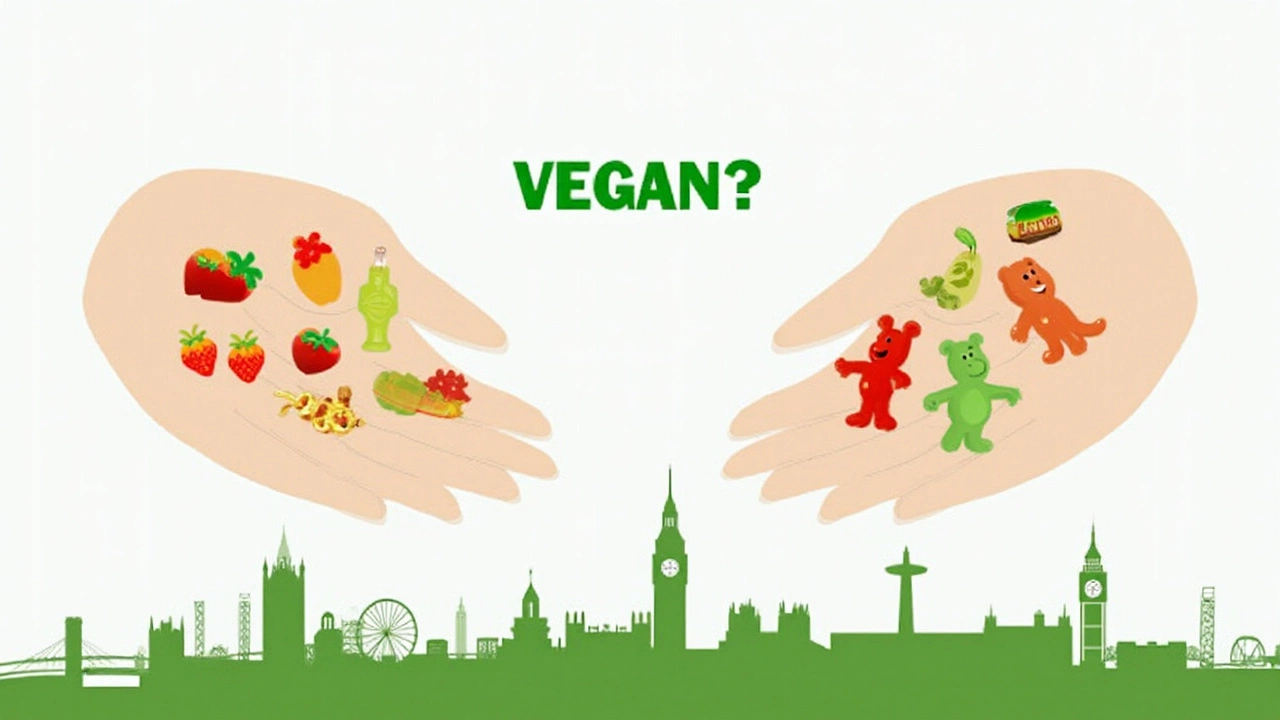You’ve probably torn open a bag of Haribo gummies and popped a chewy bear or two into your mouth without giving it a second thought. But if you’re vegan, or even just thinking about eating more plant-based, you might’ve wondered if those colorful, wobbly treats are actually vegan friendly. Spoiler: if you love cute animals like my mischievous cat Whiskers, you might be in for a surprise. Sometimes what makes that candy so addictive isn’t exactly in line with the vegan lifestyle.
What’s Actually Inside Haribo Gummies?
Let’s get right to it: Haribo’s classic gummy bears and goldbears are not vegan. The main ingredient to watch out for is gelatin. It sounds harmless until you realize gelatin is made by boiling animal skin, tendons, ligaments, and bones—usually from pigs or cows. Pretty unappetizing, right? Gelatin is what gives gummy bears that signature bouncy, chewy texture. If you scan the back of most Haribo bags, "gelatin" is always there, lurking in the ingredient lists.
This isn’t just some obscure fact, either. On Haribo’s official FAQ page, they openly say most of their products contain animal-based gelatin. They use pork gelatin in much of their European line, and beef gelatin for their products in Turkey. Vegans, vegetarians, and even many people keeping kosher or halal need to avoid most regular Haribo gummies. It’s not just the bears—wheels, rings, and other classic shapes all get their bounce from gelatin.
Now, it would be nice if the questionable ingredient list ended there, but unfortunately, that’s not always the case. Some Haribo products also use beeswax as a glossy coating. Beeswax is another no-go for vegans because it’s made by—you guessed it—bees. Sometimes, they’ll add carmine (from crushed bugs) to brighten up red-colored candies, which adds yet another sneaky animal product. And those flavorings and colorings? In some regions, they can be animal-derived too, like shellac or bone-char-filtered sugar. Eating candy shouldn’t feel like a trip through a chemistry lab, but here we are.
To make things more confusing, Haribo has production facilities around the world, and sometimes recipes change based on local laws or consumer preferences. So, a bag you pick up in London might differ from the same candy in Berlin or Istanbul. Always check your packaging, but don’t get your hopes up high for a vegan version in the regular grocery aisle. Here’s a quick summary of the most common animal ingredients you’ll spot in classic Haribo:
- Gelatin (from pigs or cows)
- Beeswax (from bees)
- Carmine/cochineal (from bugs)
- Lactose (milk—rare, but check those creamy gummies)
If you need a clearer idea, check out this table for a few of Haribo’s staple products in Europe and their key non-vegan ingredients:
| Haribo Product | Main Animal Ingredient | Vegan? |
|---|---|---|
| Goldbears | Gelatin (Pork) | No |
| Happy Cola | Gelatin (Pork) | No |
| Berries | Gelatin (Pork), Beeswax | No |
| Tropifrutti (UK/EU) | Beeswax | No |
| Piratos (Nordic) | None | Yes (some regions) |
So, the big question: are Haribo vegan? The blunt answer is almost always no, especially if you’re talking about the world-famous gummies. But the candy aisle has a few curveballs, so keep reading before you give up on all things squishy and sweet.
Which Haribo Products Are Vegan—or Come Close?
You wouldn’t think a candy brand famous for smiley neon bears would ever go animal-free, but there are a few exceptions in the Haribo lineup. Unfortunately, these are much rarer than you might hope and are not always available everywhere. If you find a store that sells them, consider yourself lucky.
Let’s start with the outlier: Haribo Sour S’ghetti. In the UK and a few parts of Europe, these are made with starches (like corn and wheat) instead of gelatin. However, there’s a catch—they often contain beeswax or shellac, which still makes them vegetarian but not truly plant-based.
Another blink-and-you’ll-miss-it example is Haribo’s Piratos and Salino (licorice coins or wheels) in Scandinavia, where some versions are made completely vegan. This is proof that sometimes a candy can get its signature texture from plant starches and not animals. In the U.S., though, there isn’t an official vegan Haribo product, so don’t get your hopes up when you check your bodega shelves.
There’s also been occasional hype online about the “Happy Cherries” and “Rainbow Fizz” varieties in Germany and the UK, but even those typically use beeswax for coating. Every now and then, Haribo will rethink recipes for certain markets, usually driven by demand from vegetarians and vegans or by the need to comply with vegetarian-friendly rules. But it’s not the norm.
If you’re after a true vegan candy from Haribo, your options are slim. But if you’re traveling to places like Sweden or Denmark, check for the “Vegan” or “Vegetarisk” label—which means no gelatin or other obvious animal stuff. Don’t assume that just because something is fruit-flavored or doesn’t look “creamy” that it’s vegan. Gummies are sneaky!
If you need an easy hack for checking candies on the fly: always read the back. Look for gelatin, beeswax (E901), shellac (E904), carmine (E120), and any milk powders. If you see any of that, nope, not vegan. With some luck, more vegan versions might pop up as customer demand grows, but right now, Haribo isn’t leading the charge into animal-free territory.

Why Isn’t Haribo Making All Gummies Vegan Already?
Alright, if it’s possible to make chewy, bouncy gummies without animal bits, why isn’t Haribo just doing it? It comes down to a few gritty reasons. First, tradition. Haribo pretty much invented the modern gummy bear, and they’ve been making them the same way since 1922. The formula, the bounce, the way the bear feels in your teeth—that’s all thanks to gelatin, and Haribo doesn’t want to mess up a classic.
Second is the cost factor. Plant-based gels, like agar-agar, pectin, and starches, often behave differently in big factory batches. It takes expensive trials and lots of testing to match that signature "spring" or chewiness that fans expect. For Haribo, making the switch means overhauling their factories, changing supply chains, and risking the wrath of die-hard fans who’d notice if their beloved candy changed texture overnight.
Then there’s the global market. Haribo operates in over 100 countries, and tastes (plus laws) aren’t always the same everywhere. In some places, pig gelatin is simply cheaper and easier to source. In others, like Turkey, religious preferences mean they use beef gelatin. Crafting one universal, plant-based recipe for all markets would take serious effort—and massive cost.
That said, the winds are starting to change. The global vegan market grew by almost 12% last year, and the rise of plant-based eating is impossible to ignore. Smaller companies have proven it’s possible to make juicy, chewy, tasty vegan gummies using things like pectin (from fruit peels), agar-agar (from seaweed), and modified starches. In taste tests, a lot of people can’t even tell the difference anymore.
Fun fact: in 2016, Haribo Germany announced they were “investigating vegan recipes,” responding to pressure from groups like PETA and the thousands of emails from customers asking for animal-free treats. So there’s hope, but don’t toss out your gelatin-free sweets just yet.
Best Vegan Gummy Alternatives to Haribo
Don’t worry—your sweet tooth isn’t doomed if you’re vegan or just squeamish about eating boiled bones. The candy world woke up to the demand for chewy, vegan treats, and there are plenty of alternatives now if you need to ditch the classic bears.
- Sour Patch Kids – Maybe the most popular American vegan-friendly choice. No gelatin, just sugar, starch, and tartness. If you like your candy puckering and punchy, these hit the spot. Note: While they don’t have animal-based gelatin, U.S. versions aren’t always made with vegan sugar (bone char can sneak in), so check if that matters to you.
- Swedish Fish – These chewy, iconic candies are gelatin-free and made with modified food starch. They have a different chew than Haribo, but they’ll ease your candy cravings, 100% guilt-free.
- JOM Organic Gummy Candy – This Scandinavian brand is fully certified vegan. They use pectin and natural flavors, with no artificial colors or weird aftertastes.
- Vegummies by Annie’s – Annie’s has a line of organic bunnies and fruit snacks made from pectin and fruit juices, so your gummies actually come from, well, plants.
- Biona Organic Sweets – Based in the UK, they’ve built a reputation for clean, pectin-based, vegan sweets with sophisticated fruit flavors. No animal by-products, no shady coatings.
If you want to experiment at home, you can even whip up your own vegan gummies. Grab fruit juice, a sweetener like agave, and a gelling agent like agar-agar or pectin. Heat gently with the gelling stuff stirred in, pour into molds (cats, bears, dinosaurs—let your imagination run wild), and set them in the fridge. No mystery ingredients, just chewy fruit bites with a side of bragging rights.
And if you’re in Europe or the UK, keep an eye on specialty vegan sections in big supermarkets. The selection is getting wider every year. For example, Katjes and Veganz are two big German brands that ditched animal gelatin in lots of their gummy lines. You might even find vegan marshmallows, which are a rare win for plant-based snackers.
If you do end up missing Haribo’s classic vibe—nostalgia and all—treat yourself. Just remember: the great candy adventure is far from over. Someone, somewhere, is working on the perfect vegan bear right now (and maybe a few cat-shaped gummies for folks like me).





